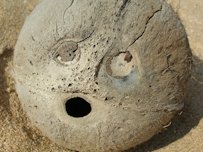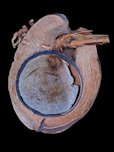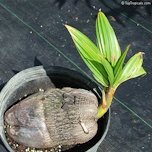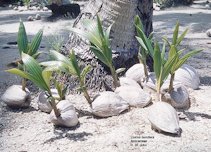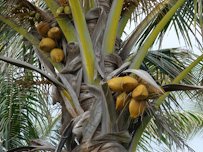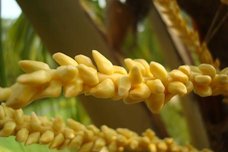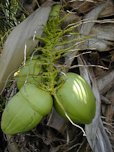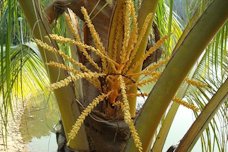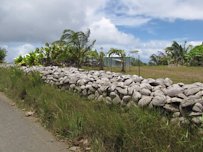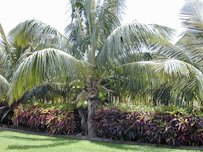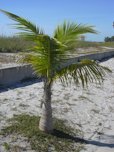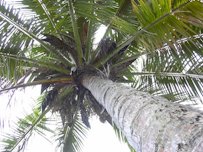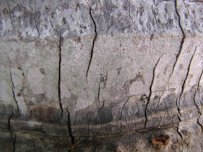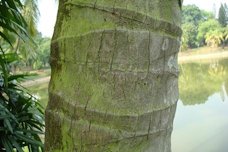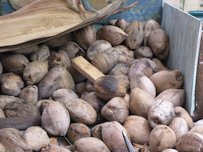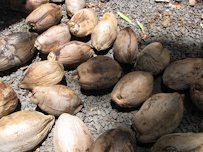Coconut Images Roughly ovoid, up to 15 inches (38 cm) long and 12 inches (30 cm) wide, composed of a thick, fibrous husk surrounding a somewhat spherical nut with a hard, brittle hairy shell. The nut is 6-8 inches (15-20 cm) in diameter and 10-12 inches (25-30 cm) long. Three sunken holes of softer tissue - called "eyes" - are at one end of the nut.
Inside the shell is a thin, white, fleshy layer, about one inch thick at maturity. This layer is known as the "meat" or copra. The interior of the nut is hollow, but partially filled with a watery liquid called "coconut milk". The meat is soft and jelly-like when immature, but it becomes firm at maturity. Coconut milk is abundant in unripe fruits, but the coconut milk is gradually absorbed as ripening proceeds. The fruits are green at first, turning brownish as they mature. Yellow-fruit varieties change from yellow to brown as they mature. Coconut Palm propagation is entirely from seed – the coconuts, which are ready for planting if they produce an audible "sloshing" sound when shaken. The nuts are placed on their sides and buried with sand or mulch to about one-half the thickness of the nut. They may be planted in closely spaced rows in well drained seedbeds, or the nuts may be planted directly into large pots. Germination is best under high temperatures (90-100 °F). Upon germination, the shoot and root emerge through the side or one end of the nut. Young palms, about 6 months old, can be transplanted directly into the field or can be grown in pots in the nursery for a few more years.
The coconut palm starts fruiting 6-10 years after the seed germinates and reaches full production at 15-20 years of age. The tree continues to fruit until it is about 80 years old, with an annual production of 50-200 fruits per tree, depending on cultivar and climate. The fruits require about a year to develop and are generally produced regularly throughout the year.
Back to Coconut Page |
||||||||||||||||||||||||||||||||||||||||||||
| Bibliography Broschat, T. K., and Jonathan H. Crane. "The Coconut Palm In Florida." Horticultural Sciences Dept., UF/IFAS Extension, HS40, Original Pub. date Apr. 1984, Rev. June 2011, June 2014, Dec. 2017 and Dec. 2020, AskIFAS, edis.ifas.ufl.edu/mg043. Accessed 4 Nov. 2015, 12 Mar. 2019, 8 Mar. 2024. Photographs Fig.1 Starr, Forest and Kim. "Fruit Honokanaia, Kahoolawe." Starr Environmental, 2005, (CC BY 4.0), starrenvironmental.com. Accessed 3 May 2014. Fig. 2 Zell, H. "Cocos nucifera, Arecaceae, Coconut Palm, longitudinal section fruit." Botanical Garden KIT, Karlsruhe, Germany, Wikimedia Commons, 2010, commons.wikimedia.org. Accessed 3 May 2014. Fig. 3,4 "Cocos nucifera." Top Tropicals, toptropicals.com. Accessed 15 Oct. 2013. Fig. 5 St-John, H. "Cocos nucifera." University of Hawai'i, Botany Department, Mānoa Campus Plants, botany.hawaii.edu. Accessed 12 Oct. 2013. Fig. 6,7,10,11,18 Kwan. "Cocos nucifera." The Plant Observatory, 2009, natureloveyou.sg. Accessed 20 Oct. 2013. Fig.9 Starr, Forest, and Kim. "Fruit at Community Garden Sand Island, Midway Atoll." Starr Environmental, 2008, (CC BY 4.0), starrenvironmental.com. Accessed 3 May 2014. Fig.12 Starr, Forest, and Kim. "Fence made out of husks at Huelo, Maui." Starr Environmental, 2009, (CC BY 4.0), starrenvironmental.com. Accessed 3 May 2014. Fig.8, 13 Starr, Forest, and Kim. "Habit Kahului, Maui." Starr Environmental, 2001, (CC BY 4.0), starrenvironmental.com. Accessed 3 May 2014. Fig.11 Starr, Forest, and Kim. "Leaves at Makawao, Maui." Starr Environmental, 2006, (CC BY 4.0), starrenvironmental.com. Accessed 3 May 2014. Fig.14,15 Starr, Forest, and Kim. "Habit at Deering Park and Lido Beach, Florida." Starr Environmental, 2003, (CC BY 4.0), starrenvironmental.com. Accessed 3 May 2014. Fig.16 Starr, Forest, and Kim. "Canopy at Lelekea, Maui." Starr Environmental, 2004, (CC BY 4.0), starrenvironmental.com. Accessed 3 May 2014. Fig.17,18 Starr, Forest, and Kim. "Trunk at Waihee, Maui." Starr Environmental, 2009, (CC BY 4.0), starrenvironmental.com. Accessed 3 May 2014. Fig. 19,20,21,22 Starr, Forest, and Kim. "Nut Husking at Nahiku, Market Place, Maui, 2009, (CC BY 4.0), starrenvironmental.com. Accessed 3 May 2014. Published 12 Oct. 2013 LR. Last update 17 Mar. 2024 LR |
||||||||||||||||||||||||||||||||||||||||||||
